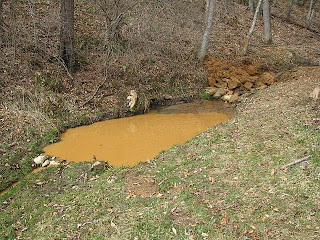



Over spring break I helped out on a small stream/pond restoration project. The project began 4 years ago to restore a small section of stream in southern Virginia after a dam was constructed. The dam’s construction drastically changed the stream, especially at the portion entering the lake and leaving it. The restoration effort was not done well and there were many features that were unsuitable for the particular soil type and peak runoff rates. Among the problems was the fact that the initial plans did not account for large spring melts, such as the one 2 years ago that destroyed much of the previous restoration work.
In this particular section, we were removing deposited soil and debris to create a riffle section to flow into a settling pond. During the construction, large quantities of sediment were controlled with the deposition pond and later removed from the pool to restore it as well. Banks were also cleared of any invasive Japanese honeysuckle and multiflora rose to encourage native dogwoods and beeches.
By restoring the section of stream that had become clogged with clay, loam, and leaves back to its original rocky bed, biota that used to live there will be able to return. Macroinvertebrates, such as caddisfly larvae and stonefly nymphs are already present in the restored upper section and will hopefully spread downstream quickly. Also, the restored natural overhanging will ensure that the water remains cool and shaded and that the banks remain intact during future spring melts.
No comments:
Post a Comment